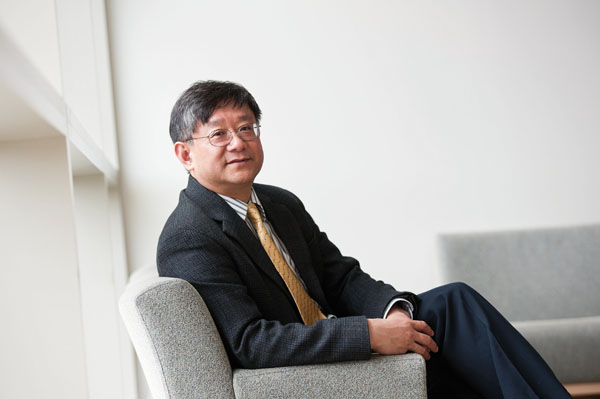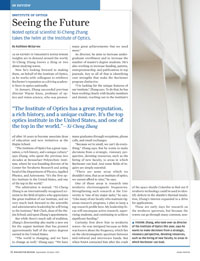In Review
 VISION: Zhang, who took over as director of the Institute of Optics this year, says he wants to make decisions from a strategic,
visionary perspective, devoting resources, such as the hiring of new faculty, to areas in which Rochester can lead. (Photo: Adam Fenster)
VISION: Zhang, who took over as director of the Institute of Optics this year, says he wants to make decisions from a strategic,
visionary perspective, devoting resources, such as the hiring of new faculty, to areas in which Rochester can lead. (Photo: Adam Fenster)As an expert in terahertz waves whose insights are in demand around the world, Xi-Cheng Zhang knows a thing or two about studying waves.
Now he’s looking forward to making them, on behalf of the Institute of Optics, as he works with colleagues to reinforce Rochester’s reputation as a driving academic force in optics nationally.
In January, Zhang succeeded previous director Wayne Knox, professor of optics and vision science, who was promoted after 10 years to become associate dean of education and new initiatives at the Hajim School.
“The Institute of Optics has a great reputation, a rich history, and a unique culture,” says Zhang, who spent the previous two decades at Rensselaer Polytechnic Institute, where he was founding director of its Center for Terahertz Research and acting head of the Department of Physics, Applied Physics, and Astronomy. “It’s the first optics institute in the United States, and one of the top in the world.”
The admiration is mutual. “Xi-Cheng Zhang is an internationally recognized scientist in the field of optics who appreciates the great tradition of our institute, and we very much look forward to the scientific and administrative leadership he will bring to the institute,” Rob Clark, dean of the Hajim School, said upon Zhang’s appointment.
But while there’s much talk of tradition, Zhang’s directorship also marks a new era for the august institute that has granted approximately half of the optics degrees earned in the United States.
“The world is changing, and we have to change as well,” Zhang says. “We have many great achievements—but we need more.”
As director, he aims to increase undergraduate enrollment and to increase the number of master’s degree students. He’s also working to increase funding, patents, entrepreneurship, and publications in top journals. Key to all of that is identifying core strengths that make the Rochester program distinctive.
“I’m looking for the unique features of our institute,” Zhang says. To do that, he has been working closely with faculty members and alumni, reaching out to the institute’s many graduates through receptions, phone calls, and email exchanges.
“Because we’re small, we can’t do everything,” Zhang says. But he wants to make decisions from a strategic, visionary perspective, devoting resources, such as the hiring of new faculty, to areas in which Rochester can lead. And some fields of inquiry are simply essential.
“There are some areas which we shouldn’t miss, that as an institute of optics, we cannot afford to miss,” he says.
One of those areas is research into terahertz electromagnetic frequencies. Strengthening such research at the University is “one of my major tasks,” he says. “Like many of our faculty who maintain rigorous research programs, I plan to keep a top research profile here. My leadership focus will encompass active research, supervising students, and continuing to achieve significant funding.”
Curiosity first drew him to terahertz waves—he was intrigued because so little was known about the frequency, which lies on the electromagnetic spectrum between mid-infrared and microwave bands. But when NASA contacted him after the crash of the space shuttle Columbia to find out if terahertz technology could be used to identify defects in the shuttle’s thermal insulation, Zhang’s interest expanded to a drive for applications.
These are early days for research on the terahertz spectrum, but because the waves can go through many common, non- metallic materials, the work shows promise for applications in a wide variety of areas, from security and defense—identifying explosives and other dangerous chemicals from a distance of up to 30 meters away—to pharmaceuticals and art restoration and conservation.
For example, terahertz technology “has potential for homeland security applications,” he says, allowing airports to move away from backscatter x-rays, a method that has raised public concerns about privacy and safety.
The likely usefulness of terahertz waves for defense and homeland security has brought Zhang international attention. He recently retired as chair of a pair of NATO organizations, and this summer he received an honorary professorship from Moscow State University, recognition that has been awarded sparingly to scientists.
Participation in research of such immediate global interest has kept Zhang on the move. “I traveled 290,000 miles one year,” he says. “It’s 230,000 miles to the moon. There are a lot of meetings and organizations interested in terahertz technology.”
While at Rensselaer, Zhang established a company, Zomega Terahertz Corporation, dedicated to developing and establishing terahertz-technology applications. He hopes to help encourage entrepreneurship at the institute, where, he notes, there is already a long history of establishing companies by faculty, alumni, and students and a tradition of strong relationships with industry.
“I feel this is good for society, and good for our institute as well,” he says.
And despite the demanding pace of his research, his eyes are firmly on the plans he’s developing for the institute.
“I have a chance to work with a large group of the best faculty in the world, to achieve our goal together.”

